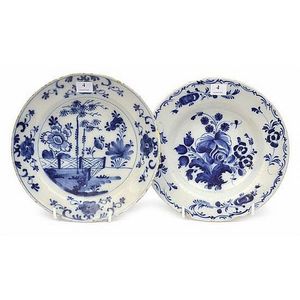Meissen Blue Onion Porcelain Cabinet Plates (Pair)
You must be a subscriber, and be logged in to view price and dealer details.
Subscribe Now to view actual auction price for this item
When you subscribe, you have the option of setting the currency in which to display prices to $Au, $US, $NZ or Stg.
- Onion Pattern - The onion pattern is a popular design motif used in the decoration of porcelain, especially in European and Chinese porcelain. It typically consists of a central motif, such as a flower or bird, surrounded by concentric circles of leaves, flowers, and other decorative elements. The onion pattern originated in China during the Ming dynasty (1368-1644) and was later adapted by European porcelain makers in the 18th century, by companies such as Meissen, Royal Copenhagen and Hutschenreuther, and in England by manufacturers such as Royal Wedgwood, Crown Derby and Spode. The name "onion pattern" is thought to have originated from the shape of the central motif, which resembles an onion or a pomegranate. The pattern is often executed in underglaze blue, but it can also be found in other colours such as red, green, and gold.
- Gilding - Gilding is a method of ornamentation whereby a thin sheet of gold metal is applied to items made of wood, leather, ceramics, glass and silver for decorative purposes.
For furniture including mirrors, the sheet of gold is usually applied over a coating of gesso. Gesso is a mixture of plaster of Paris and gypsum mixed with water and then applied to the carved wooden frames of mirrors and picture frames as a base for applying the gold leaf. After numerous coats of gesso have been applied, allowed to dry and then sanded a coat of "bole", a usually red coloured mixture of clay and glue is brushed on and allowed to dry, after which the gold leaf is applied. Over time parts of the gilding will rub off so the base colour can be seen. In water gilding, this was generally a blue colour, while in oil gilding, the under layer was often yellow. In Victorian times, gilders frequently used red as a pigment beneath the gold leaf.
Metal was often gilded by a process known as fire gilding. Gold mixed with mercury was applied and heated, causing the mercury to evaporate, the long-term effect of which was to kill or disable the craftsman or woman from mercury poisoning. The pursuit of beauty has claimed many victims, not the least of which were the artists who made those pieces so highly sought after today. - Basket Weave / Basketweave - Basket weave is a decorative pattern that is often used in textiles, ceramics, furniture and other decorative arts. It is created by actual or simulated interweaving of horizontal and vertical threads or strips to create a pattern that resembles a woven basket.
In textiles, basket weave can be created using various materials such as fabric, yarn, or ribbon. It is often used to create decorative details on clothing, upholstery, and other household items. Simulated basket weave can also be created using ceramic clay, timber or other materials, and it is often used to decorate pottery, tiles, furniture, silver and other decorative objects.
Basket weave patterns can vary in complexity, from simple, straightforward designs to more intricate, elaborate patterns. The size and spacing of the interwoven threads or strips can also be varied to create different effects. Basket weave is often used to create a natural, rustic look and is often associated with traditional crafts and folk art.
This item has been included into following indexes:
Visually similar items

A pair of 18th century blue and white plates, 22.5 cm diameter

Two Victorian 'Flow blue' English platters, 19th century, including an ironstone H Adams 'Fairy Villas' platter and one other. Length 40 cm. Width 33 cm. And smaller

A Kangxi blue and white shipwreck cup and saucer, Qing Dynasty, circa 1700, unknown shipwreck, the delicately modelled cup and saucer with finely scalloped rims and lobed cells, each decorated in underglaze blue with floral emblems and butterflies, the sau

Spode eight place dinner service in blue & white Italian pattern (76pcs)
